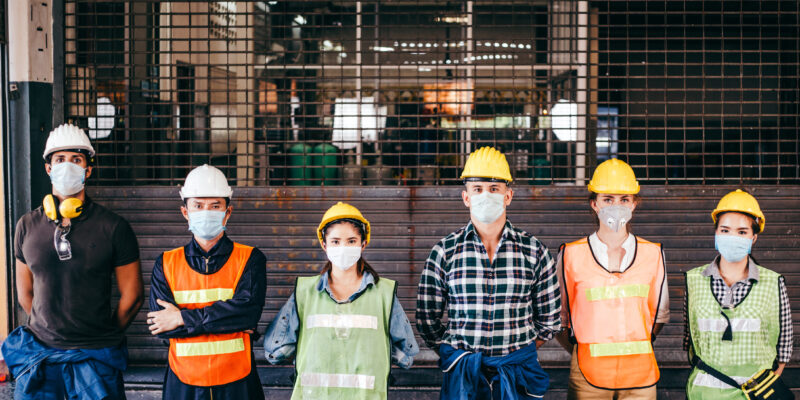The 2020 COVID-19 pandemic and the construction industry have had an interesting relationship this year. Some construction projects are essential and others aren’t. Even though many construction workers continued their jobs as the virus raged on, PPE and social distancing measures weren’t as universally applicable. This has caused some confusion as different states take different approaches.
So, what are the best practices for people working in the construction industry today? How do we keep our teams safe while still generating revenue?
Read the below tips on keeping your workforce healthy with reasonable precautions suggested by the CDC, OSHA, and others.
Masks
OSHA and the CDC recommend wearing a face covering whenever possible, but especially when social distancing from others is not possible.
Given the varying environments workers may find themselves in on work sites, it may not be realistic for employees to cover their faces if they…
- Work alone or significantly distanced from others
- Work outdoors and/or in the extreme heat
- Get their face covering soiled, wet, or dirty during their shift
- Must already wear a face covering, mask, or face shield for their work
However, if a team of workers spend a shift together, indoors, working on a project that requires them to be within 6 feet of each other at times, then masks are highly recommended.
Social Distancing
The Occupational Safety and Health Administration (OSHA) provides this guideline chart regarding COVID-19 risk on construction work sites:
| Lower Risk (Caution) | Medium Risk | High Risk | Very High Risk |
| Tasks that allow employees to remain at least 6 feet apart and involve little contact with the public, visitors, or customers. No special precautions. | Tasks that require workers to be within 6 feet of one another. Tasks that require workers to be in close contact (within 6 feet) with customers, visitors, or members of the public. Masks should be worn. | Entering an indoor work site occupied by people such as other workers, customers, or residents suspected of having or known to have COVID-19, including when an occupant of the site reports signs and symptoms consistent with COVID-19. Consider delaying this work. | Category not applicable for most anticipated work tasks. Note: Most construction work tasks are associated with no more than high exposure risk; see the work tasks associated with lower, medium, or high risk on this chart. Unlikely to occur in construction. |
Like in the previous example of workers together indoors for a full shift, any work site falling in the Medium column should require face coverings. When your project has a High Risk due to possible COVID exposure, the project should be delayed if possible.

Sick Time & Administrative Controls
Every project manager should also consider administrative controls as additional precautionary measures. The following steps could effectively prevent an outbreak among your staff and demonstrate to your team and clients that you’re taking their health seriously:
- Stagger shift start/end times and reduce traffic in high-congestion areas to promote social distancing (ex: open additional break rooms)
- Adopt flexible sick time policies that encourage workers to stay home when sick
- Introduce thermal scanning or screening questions when entering buildings
- Increase sanitation practices
- Reduce in-person meetings
The Future
It’s not just construction. Numerous industries are balancing the tightrope of maintaining operations and keeping employees and clients safe.
Fortunately, we live in a time when technology and available resources can meet the demands of a “new normal.” As long as project managers continue to assess safety, follow safety guidelines, and explore new options, sites will be safe and we’ll keep building.
Keep an eye out for next week’s blog post on one technology that’s taking construction by storm! In the meantime, connect with Steadfast on LinkedIn.

